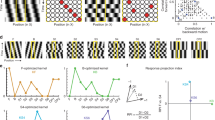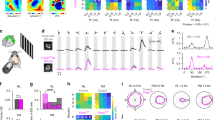Abstract
Development of the selective response properties that define columns in sensory cortex is thought to begin early in cortical maturation, without the need for experience. We investigated the development of direction selectivity in ferret visual cortex using optical imaging and electrophysiological techniques and found an exception to this view. Unlike orientation selectivity and ocular dominance, direction selectivity was not detected at eye opening. Direction selectivity emerged several days later and strengthened to adult levels over the following 2 weeks. Visual experience was essential for this process, as shown by the absence of direction selectivity in dark-reared ferrets. The impairment persisted in dark-reared ferrets that were given experience after this period, despite the recovery of response amplitude, preference and bandwidth for stimulus orientation, spatial and temporal frequency, and contrast. Visual experience in early postnatal life plays a necessary and unique role in the development of cortical direction selectivity.
This is a preview of subscription content, access via your institution
Access options
Subscribe to this journal
Receive 12 print issues and online access
$209.00 per year
only $17.42 per issue
Buy this article
- Purchase on Springer Link
- Instant access to full article PDF
Prices may be subject to local taxes which are calculated during checkout




Similar content being viewed by others
References
Hubel, D.H. & Wiesel, T.N. Receptive fields of cells in striate cortex of very young, visually inexperienced kittens. J. Neurophysiol. 26, 994–1002 (1963).
Chapman, B. & Stryker, M.P. Development of orientation selectivity in ferret visual cortex and effects of deprivation. J. Neurosci. 13, 5251–5262 (1993).
Horton, J.C. & Hocking, D.R. An adult-like pattern of ocular dominance columns in striate cortex of newborn monkeys prior to visual experience. J. Neurosci. 16, 1791–1807 (1996).
Crair, M.C., Gillespie, D.C. & Stryker, M.P. The role of visual experience in the development of columns in cat visual cortex. Science 279, 566–570 (1998).
White, L.E., Coppola, D.M. & Fitzpatrick, D. The contribution of sensory experience to the maturation of orientation selectivity in ferret visual cortex. Nature 411, 1049–1052 (2001).
Sengpiel, F. & Kind, P.C. The role of activity in development of the visual system. Curr. Biol. 12, R818–R826 (2002).
Katz, L.C. & Crowley, J.C. Development of cortical circuits: lessons from ocular dominance columns. Nat. Rev. Neurosci. 3, 34–42 (2002).
Wiesel, T.N. & Hubel, D.H. Ordered arrangement of orientation columns in monkeys lacking visual experience. J. Comp. Neurol. 158, 307–318 (1974).
Chapman, B., Stryker, M.P. & Bonhoeffer, T. Development of orientation preference maps in ferret primary visual cortex. J. Neurosci. 16, 6443–6453 (1996).
Frégnac, Y. & Imbert, M. Early development of visual cortical cells in normal and dark-reared kittens: the relationship between orientation selectivity and ocular dominance. J. Physiol. (Lond.) 278, 27–44 (1978).
Weliky, M, Bosking, W.H. & Fitzpatrick, D. A systematic map of direction preference in primary visual cortex. Nature 379, 725–728 (1996).
Hatta, S. et al. Nasotemporal directional bias of V1 neurons in young infant monkeys. Invest. Ophthalmol. Vis. Sci. 39, 2259–2267 (1998).
Blakemore, C. & Van Sluyters, R.C. Innate and environmental factors in the development of the kitten's visual cortex. J. Physiol. (Lond.) 248, 663–716 (1975).
Imbert, M. & Buisseret, P. Receptive field characteristics and plastic properties of visual cortical cells in kittens reared with or without visual experience. Exp. Brain Res. 22, 25–36 (1975).
Zhou, Y., Leventhal, A.G. & Thompson, K.G. Visual deprivation does not affect the orientation and direction sensitivity of relay cells in the lateral geniculate nucleus of the cat. J. Neurosci. 15, 689–698 (1995).
Olson, C.R. & Pettigrew, J.D. Single units in visual cortex of kittens reared in stroboscopic illumination. Brain Res. 70, 189–204 (1974).
Cynader, M. & Chernenko, G. Abolition of direction selectivity in the visual cortex of the cat. Science 193, 504–505 (1976).
Humphrey, A.L. & Saul, A.B. Strobe rearing reduces direction selectivity in area 17 by altering spatiotemporal receptive-field structure. J. Neurophysiol. 80, 2991–3004 (1998).
Humphrey, A.L., Saul, A.B. & Feidler, J.C. Strobe rearing prevents the convergence of inputs with different response timings onto area 17 simple cells. J. Neurophysiol. 80, 3005–3020 (1998).
Issa, N.P., Trachtenberg, J.T., Chapman, B., Zahs, K.R. & Stryker, M.P. The critical period for ocular dominance plasticity in the ferret's visual cortex. J. Neurosci. 19, 6965–6978 (1999).
Liao, D.S., Krahe, T.E., Prusky, G.T., Medina, A.E. & Ramoa, A.S. Recovery of cortical binocularity and orientation selectivity after the critical period for ocular dominance plasticity. J. Neurophysiol. 92, 2113–2121 (2004).
Peterson, M., Li, B. & Freeman, R.D. Direction selectivity of neurons in the striate cortex increases as stimulus contrast is decreased. J. Neurophysiol. published online November 23 2005 (doi:10.1152/jn.00885.2005).
DeAngelis, G.C., Ohzawa, I. & Freeman, R.D. Spatiotemporal organization of simple-cell receptive fields in the cat's striate cortex. I. General characteristics and postnatal development. J. Neurophysiol. 69, 1091–1117 (1993).
Saul, A.B. & Feidler, J.C. Development of response timing and direction selectivity in cat visual thalamus and cortex. J. Neurosci. 22, 2945–2955 (2002).
Movshon, J.A., Kiorpes, L., Hawken, M.J. & Cavanaugh, J.R. Functional maturation of the macaque's lateral geniculate nucleus. J. Neurosci. 25, 2712–2722 (2005).
Cynader, M. & Mitchell, D.E. Prolonged sensitivity to monocular deprivation in dark-reared cats. J. Neurophysiol. 43, 1026–1040 (1980).
Mower, G.D., Berry, D., Burchfiel, J.L. & Duffy, F.H. Comparison of the effects of dark rearing and binocular suture on development and plasticity of cat visual cortex. Brain Res. 220, 255–267 (1981).
Bonhoeffer, T. & Grinvald, A. Optical imaging based on intrinsic signals: the methodology. Brain Mapping: the Methods (eds. Toga, A.W. & Mazziotta, J.C.) 55–97 (Academic, San Diego, 1996).
Polimeni, J.R., Granquist-Fraser, D., Wood, R.J. & Schwartz, E.L. Physical limits to spatial resolution of optical recording: clarifying the spatial structure of cortical hypercolumns. Proc. Natl. Acad. Sci. USA 102, 4158–4163 (2005).
Tavazoie, S.F. & Reid, R.C. Diverse receptive fields in the lateral geniculate nucleus during thalamocortical development. Nat. Neurosci. 3, 608–616 (2000).
Ruthazer, E.S. & Stryker, M.P. The role of activity in the development of long-range horizontal connections in area 17 of the ferret. J. Neurosci. 16, 7253–7269 (1996).
Durack, J.C. & Katz, L.C. Development of horizontal connections in layer 2/3 of ferret visual cortex. Cereb. Cortex 6, 178–183 (1996).
Moore, B.D., Alitto, H.J. & Usrey, W.M. Orientation tuning, but not direction selectivity, is invariant to temporal frequency in primary visual cortex. J. Neurophysiol. 94, 1336–1345 (2005).
Ruthazer, E. You're perfect, now change – redefining the role of developmental plasticity. Neuron 45, 825–828 (2005).
Ruthazer, E.S., Baker, G.E. & Stryker, M.P. Development and organization of ocular dominance bands in primary visual cortex of the sable ferret. J. Comp. Neurol. 407, 151–165 (1999).
Crowley, J.C. & Katz, L.C. Early development of ocular dominance columns. Science 290, 1321–1324 (2000).
Shmuel, A. & Grinvald, A. Functional organization for direction of motion and its relationship to orientation maps in cat area 18. J. Neurosci. 16, 6945–6964 (1996).
Kisvarday, Z.F., Buzas, P. & Eysel, U.T. Calculating direction maps from intrinsic signals revealed by optical imaging. Cereb. Cortex 11, 636–647 (2001).
Swindale, N.V., Grinvald, A. & Shmuel, A. The spatial pattern of response magnitude and selectivity for orientation and direction in cat visual cortex. Cereb. Cortex 13, 225–238 (2003).
Braddick, O., Birtles, D., Wattam-Bell, J. & Atkinson, J. Motion- and orientation-specific cortical responses in infancy. Vision Res. 45, 3169–3179 (2005).
Movshon, J.A., Thompson, I.D. & Tolhurst, D.J. Spatial summation in the receptive fields of simple cells in the cat's striate cortex. J. Physiol. (Lond.) 283, 53–77 (1978).
Reid, R.C., Soodak, R.E. & Shapley, R.M. Directional selectivity and spatiotemporal structure of receptive fields of simple cells in cat striate cortex. J. Neurophysiol. 66, 505–529 (1991).
Dan, Y. & Poo, M.-M. Spike timing-dependent plasticity of neural circuits. Neuron 44, 23–30 (2004).
Wenisch, O.G., Noll, J. & Hemmen, J.L. Spontaneously emerging direction selectivity maps in visual cortex through STDP. Biol. Cybern. 93, 239–247 (2005).
Tanaka, S., Miyashita, M. & Ribot, J. Roles of visual experience and intrinsic mechanisms in the activity-dependent self-organization of orientation maps: theory and experiment. Neural Netw. 17, 1363–1375 (2004).
Fitzsimonds, R.M., Song, H.-J. & Poo, M.-M. Propagation of activity-dependent synaptic depression in simple neural networks. Nature 388, 439–448 (1997).
Du, J.-L. & Poo, M.-M. Rapid BDNF-induced retrograde synaptic modification in a developing retinotectal system. Nature 429, 878–883 (2004).
Akerman, C.J., Smyth, D. & Thompson, I.D. Visual experience before eye-opening and the development of the retinogeniculate pathway. Neuron 36, 869–879 (2002).
Daw, N.W., Berman, N.E. & Ariel, M. Interaction of critical periods in the visual cortex of kittens. Science 199, 565–567 (1978).
Mower, G.D., Burchfiel, J.L. & Duffy, F.H. The effects of dark-rearing on the development and plasticity of the lateral geniculate nucleus. Brain Res. 227, 418–424 (1981).
Acknowledgements
We thank T. Tucker and E. Johnson for assistance with analysis of optical imaging data, A. Basole for help with data collection, and members of the Fitzpatrick lab for critical comments. This work was supported by grants from the Whitehall Foundation to L.E.W. and the US National Institutes of Health to D.F.
Author information
Authors and Affiliations
Corresponding author
Ethics declarations
Competing interests
The authors declare no competing financial interests.
Supplementary information
Supplementary Fig. 1
Ocular dominance in light-reared and dark-reared juvenile ferrets revealed by intrinsic signal optical imaging. (PDF 797 kb)
Supplementary Fig. 2
Orientation and direction selectivity signal in light-reared and dark-reared juvenile ferrets. (PDF 1533 kb)
Supplementary Fig. 3
Tuning of single unit recordings from layer 2/3 of V1 in dark-reared juvenile ferrets. (PDF 45 kb)
Supplementary Fig. 4
The effects of varying spatial and temporal frequency and stimulus contrast on orientation selectivity in juvenile ferrets reared under different conditions of visual experience. (PDF 1566 kb)
Supplementary Table 1
Direction selectivity of multi-unit recordings from layer 2/3 of V1 in light-reared and dark-reared juvenile ferrets. (PDF 45 kb)
Supplementary Table 2
Spatial and temporal frequency tuning and contrast sensitivity in V1 of light-reared and dark-reared juvenile ferrets and in dark-reared ferrets that were given late visual experience. (PDF 63 kb)
Rights and permissions
About this article
Cite this article
Li, Y., Fitzpatrick, D. & White, L. The development of direction selectivity in ferret visual cortex requires early visual experience. Nat Neurosci 9, 676–681 (2006). https://doi.org/10.1038/nn1684
Received:
Accepted:
Published:
Issue Date:
DOI: https://doi.org/10.1038/nn1684
This article is cited by
-
Functional neuronal circuits emerge in the absence of developmental activity
Nature Communications (2024)
-
Retina-derived signals control pace of neurogenesis in visual brain areas but not circuit assembly
Nature Communications (2023)
-
A cross-species assay demonstrates that reward responsiveness is enduringly impacted by adverse, unpredictable early-life experiences
Neuropsychopharmacology (2022)
-
Temporal stability of stimulus representation increases along rodent visual cortical hierarchies
Nature Communications (2021)
-
Portrait of visual cortical circuits for generating neural oscillation dynamics
Cognitive Neurodynamics (2021)



